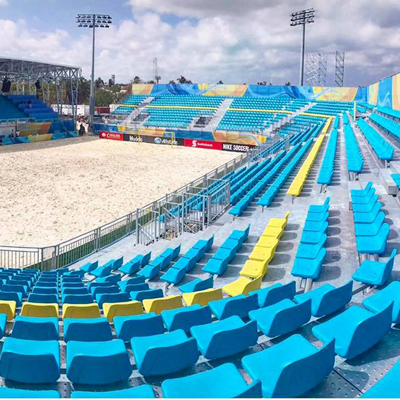What Innovations are Transforming Disability Access in Sports?

Sports have always been a platform for human achievement, but what happens when physical limitations come into play? In recent years, the world of adaptive sports has seen a surge of innovations that are transforming disability access and empowering athletes with physical impairments.
These groundbreaking innovations are redefining what is possible, providing individuals with disabilities the freedom to excel in sports and participate in competitive events just like their able-bodied counterparts. From advanced prosthetic limbs to cutting-edge assistive technologies, the boundaries of disability in the sporting arena are being pushed further than ever before.
Inclusive design principles are at the forefront of this revolution, ensuring that sports facilities, equipment, and programs are accessible to athletes of all abilities. With forward-thinking approaches, accessibility is no longer an afterthought but an integral part of the design process.
In this article, we will explore the latest advancements in disability access in sports, highlighting the technologies and strategies that are revolutionizing the way athletes with disabilities pursue their passions. Join us as we delve into the world of adaptive sports and discover the incredible innovations making sports more inclusive than ever.
The Importance of Inclusivity in Sports
Sports have always had the power to unite people from all walks of life. They bring communities together, foster teamwork, and showcase the best of human potential. However, for individuals with disabilities, accessing and participating in sports has often been a challenge due to physical barriers and limited opportunities. This lack of inclusivity not only denies disabled athletes the chance to showcase their abilities but also perpetuates societal misconceptions about disability.
In recent years, there has been a growing recognition of the importance of inclusivity in sports. The belief that everyone, regardless of their physical abilities, should have equal opportunities to engage in sports has driven the development of innovative solutions that break down barriers and level the playing field. These advancements not only benefit disabled athletes but also enrich the world of sports by diversifying talent and inspiring future generations.
Innovations in Adaptive Equipment for Disabled Athletes
One of the key areas where innovation is transforming disability access in sports is through the development of adaptive equipment. Gone are the days when athletes with disabilities had to make do with generic equipment that did not cater to their specific needs. Today, there is a wide range of specialized gear and devices designed to enhance performance and enable athletes with disabilities to compete at their best.
| Also Read: Breaking Barriers: Enhancing Disability Access in the Sports Industry |
Prosthetic limbs, for example, have come a long way in recent years. With advancements in materials and design, athletes with amputations can now choose from a variety of prosthetic limbs that mimic the function and movement of natural limbs. These high-tech prosthetics not only provide greater mobility but also allow athletes to participate in a wide range of sports, from running and cycling to swimming and skiing.
Assistive Technologies for Improved Performance
In addition to adaptive equipment, assistive technologies are playing a crucial role in transforming disability access in sports. These technologies leverage the power of innovation to enhance the performance of disabled athletes and enable them to reach their full potential.
One such technology is the use of exoskeletons, which are wearable robotic devices that provide support and assistance to individuals with mobility impairments. These exoskeletons can help athletes with spinal cord injuries, for example, to walk or even run, enabling them to participate in sports that were previously inaccessible. The development of lightweight and customizable exoskeletons is opening up new possibilities for disabled athletes, allowing them to compete in sports such as wheelchair racing or even participate in sports traditionally reserved for able-bodied individuals.
Accessible Facilities and Infrastructure in Sports Venues
Creating accessible facilities and infrastructure is another crucial aspect of transforming disability access in sports. It is not enough to develop innovative equipment and technologies if athletes with disabilities do not have equal access to sports venues and facilities. Inclusive design principles are now being incorporated into the planning and construction of sports facilities to ensure that they are accessible to athletes of all abilities.
This includes features such as accessible seating areas, ramps and elevators, wide doorways, and tactile signage for individuals with visual impairments. Additionally, sports venues are now being designed to accommodate a wide range of disabilities, including mobility impairments, sensory impairments, and cognitive impairments. By making sports venues more inclusive, athletes with disabilities can enjoy the same level of participation and spectatorship as their able-bodied counterparts.
The Role of Technology in Promoting Disability Access
Technology is playing a significant role in promoting disability access in sports. From mobile applications that provide real-time accessibility information to virtual reality simulations that allow athletes to experience different sports, technology is breaking down barriers and expanding opportunities for disabled athletes.
Mobile applications, for example, can provide information about accessible sports facilities, programs, and events in a particular area. This allows athletes with disabilities to easily locate and participate in sports activities that suit their interests and abilities. Virtual reality simulations, on the other hand, can give athletes a realistic experience of various sports, helping them to identify the ones they are most passionate about and providing a platform for training and skill development.
Examples of Successful Disability Access Initiatives in Sports
Several disability access initiatives in sports have already made a significant impact on the lives of disabled athletes. The Paralympic Games, for instance, have been instrumental in promoting inclusivity and showcasing the incredible abilities of disabled athletes on a global stage. These games provide a platform for athletes with disabilities to compete at the highest level and inspire millions around the world.
Another example is the development of wheelchair tennis, which has revolutionized the sport for individuals with mobility impairments. Through the use of specialized sports wheelchairs and modified rules, wheelchair tennis has become a highly competitive and widely recognized sport. This innovation has opened doors for disabled athletes to participate in tennis at both recreational and professional levels.
The Impact of These Innovations on Disabled Athletes and the Sports Industry
The innovations transforming disability access in sports have had a profound impact on disabled athletes and the sports industry as a whole. For disabled athletes, these advancements have provided opportunities for personal growth, empowerment, and the pursuit of their athletic dreams. They have shattered barriers and proven that physical disabilities do not define one's abilities or limit their potential.
Furthermore, these innovations have challenged societal perceptions of disability and helped to break down stereotypes. By showcasing the incredible achievements of disabled athletes, they have inspired a shift in attitudes towards disability, fostering a more inclusive and accepting society.
In the sports industry, innovations in disability access have opened up new markets and audiences. The Paralympic Games, for example, have gained significant popularity and recognition, attracting millions of viewers and sponsors. This increased visibility has not only provided disabled athletes with greater opportunities for sponsorship and endorsement but has also highlighted the economic potential of disability sports.
Challenges and Future Developments in Disability Access in Sports
While significant progress has been made in transforming disability access in sports, there are still challenges that need to be addressed. One of the main challenges is the high cost associated with adaptive equipment and assistive technologies. These innovations are often expensive, making them inaccessible to athletes from lower-income backgrounds. Efforts need to be made to ensure that these technologies are affordable and accessible to all disabled athletes.
Another challenge is the need for continued research and development. As technology advances, there is a need to constantly innovate and improve existing solutions, as well as develop new ones. This requires collaboration between researchers, engineers, and athletes to create technologies that meet the specific needs and preferences of disabled athletes.
In the future, we can expect to see further advancements in disability access in sports. From advancements in prosthetic technology to the development of new assistive devices, the possibilities are endless. Additionally, there will be a greater emphasis on inclusivity in sports design, with a focus on creating accessible and inclusive environments that cater to athletes of all abilities.
Conclusion: The Future of Disability Access in Sports
The world of adaptive sports is undergoing a revolution, thanks to the innovations that are transforming disability access. With advancements in adaptive equipment, assistive technologies, and accessible facilities, athletes with disabilities are now able to participate in sports on equal footing with their able-bodied counterparts.
The importance of inclusivity in sports cannot be overstated. It is not just about creating opportunities for disabled athletes; it is about promoting acceptance, breaking down barriers, and celebrating the diversity of human potential. As we look to the future, we must continue to push the boundaries of what is possible, ensuring that sports are truly accessible to all.
By embracing innovation, investing in research and development, and prioritizing inclusivity in sports design, we can create a future where disability is no longer a limitation in sports but a catalyst for inspiration, achievement, and unity. Together, let us champion disability access in sports and empower athletes of all abilities to reach for the stars.





